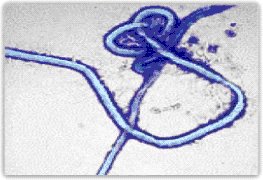Ebola Fact Sheet
|
Delivery: Person-to-person transmission requires close contact with an infected individual or items used by an infected individual. Ebola could be intentionally transmitted by an infected individual. Currently, it is not possible to aerosolize Ebola in dry form. The possibility of transmission via aerosolized liquid droplets (such as produced by sneezing) is speculated but unconfirmed. Production: Ebola exists naturally in primate populations (mainly in Africa) and occasionally spreads to human populations that are exposed to these animals. It might be possible for a terrorist to obtain the virus from these natural sources and carry the virus to a target population to initiate person-to-person transmission. Historic Use: Ebola has not been used as a bioweapon; however, bioweapon programs such as the former Soviet Union's may have investigated weaponizing Ebola. Three incidents of research scientists becoming infected after being stuck with Ebola-contaminated syringes have been reported: England, 1976 (recovered); USA, February 2004 (recovered); Russia, May 2004 (died). |
Effects: Ebola proves fatal in 50-90% of symptomatic cases. Symptoms appear 2-21 days after exposure. Onset is rapid, beginning with flu-like symptoms and progressing to chest pain, red eyes, skin rash, jaundice, hiccups, and bleeding. In fatal cases, symptoms progress over one to two weeks until the patient dies in shock or in a coma. Patients who recover may remain infectious even after symptoms abate. Treatment: There is no effective treatment for Ebola. Healthcare workers wear protective gear, when available, and every attempt is made to quarantine patients so others do not become infected. Research into an Ebola vaccine is progressing. In 2003, the National Institutes of Health (NIH) demonstrated efficacy of a vaccine in monkeys. The results of Ebola vaccine trials in humans are anticipated. |



